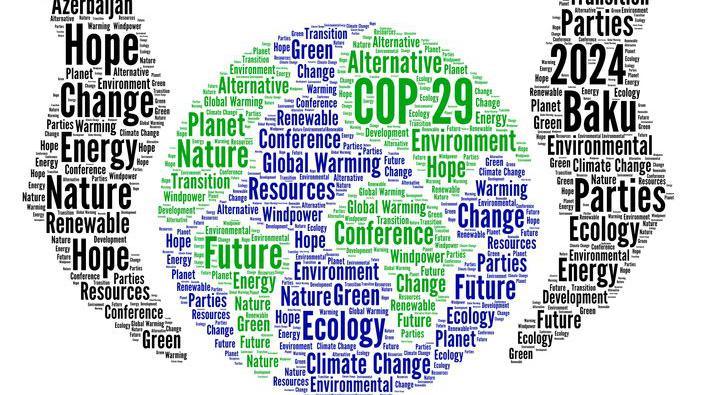COP29: What do all the words mean?

- Published
There's a giant climate change conference taking place in Azerbaijan's capital Baku, called COP29.
You're likely to hear a lot about the conference, but even if you're really interested in climate change, sometimes the scientific language used to talk about it can be tricky to understand.
That's where we come in! We've created this handy jargon-buster to explain some of the key terms you'll be hearing at COP29.
More like this
- Published20 January 2020
- Published7 November
COP29
Let's start at the beginning!
COP stands for Conference of the Parties - and it's a big meeting involving world leaders that is currently taking place in Azerbaijan.
It is attended by countries that signed the United Nations Framework Convention on Climate Change (UNFCCC).
That was an agreement made in 1992 when countries committed to avoiding any behaviours that could lead to "dangerous climate change".
World leaders from around 200 nations will attend this year's summit to discuss climate change and how to fight it.
The first COP - COP1 - took place in 1995, and the 2024 event is the 29th meeting, which is why it's called COP29.
The conference takes place every year, unless the countries involved decide otherwise.
1.5 degrees
The planet's temperature is getting warmer. Scientists say that we need to stop the rise from getting over 1.5C in order to avoid the worst impacts of climate change.
This rise would be compared to pre-industrial times, which means before the industrial revolution, which was a period of technological advancement that saw the beginning of large scale carbon emissions by humans.
According to experts, the average global temperature has already gone up by around 1C.
Carbon footprint
This refers to the amount of carbon emitted over a certain period of time, for example, your carbon footprint is bigger if you drive somewhere, than if you walk.
Individuals and groups of people, such as companies, can have carbon footprints.
Products can also have a footprint, which refers to how much carbon is emitted when they are made.
Carbon neutral
If something is carbon neutral, it means that the amount of carbon dioxide (CO2) it releases into the atmosphere is the same amount as it takes out.
Carbon dioxide (CO2) is a major cause of climate change.
Climate change
When we talk about climate change, we are talking about global changes in the Earth's average temperature.
The Earth's average temperature moves up and down naturally, but it has been increasing more rapidly than it usually does.
This change is impacting on the planet's environment
Emissions
Emissions are any releases of gases that contribute to global warming, such as CO2.
They can be smaller individual emissions such as from car engines, or they can be larger, such as those from coal-burning power stations.
Feedback loop
In a feedback loop, the rising temperatures of Earth change the environment in ways that affect how quickly the planet gets warmer.
An example of this is the sea-ice in the Arctic.
The big white ice spaces in this part of the world currently reflect the Sun's rays away, but when they melt and the surface colour becomes a darker blue or green, the Sun's rays start to get absorbed.
In short, less sea ice means more warming, which means more ice melts...
Fossil fuels
The UK's last coal plant, Ratcliffe-on-Soar Power Station near Nottingham, finished operations in September
Much of the worldÔÇÖs energy is produced by burning fossil fuels such asÔÇ»oil,ÔÇ»coalÔÇ»andÔÇ»gas.
These natural resources are used to power everything from planes to gas cookers and once fossil fuels are gone, they cannot be replaced.
Burning fossil fuels createsÔÇ» emissions which impact climate change, cause pollution and damage the enivronment.
Geo-engineering
This is any technology that can help in the fight against climate change.
Some people think that geo-engineering will be crucial in tackling climate change, but others believe that changing behaviours (like taking fewer flights) will be far more important.
Global warming
The rise in the planet's average temperature.
Scientists say that humans are the main cause of this happening.
Greenhouse gases
Greenhouse gases are the gases in the EarthÔÇÖs atmosphere that trap heat.
Experts says their rising levels is a cause of global warming.
The main ones are carbon dioxide (CO2), methane, nitrous oxide and CFCs (chloroflurocarbons).
IPCC
This stands for the Intergovernmental Panel on Climate Change.
It's a group that was set up by the United Nations and World Meteorological Organisation.
Its role is to analyse scientific research on climate change.
Net zero
Net zero is the name given to the point at which a country is taking as much of these climate-changing gases out of the atmosphere as it is putting into the atmosphere - so overall, the total is zero.
This means that any emissions produced by homes, transport, farming and industry have to be reduced or balanced out by removing the same amount from the atmosphere.
This usually occurs through planting trees, which absorb carbon in their wood, or by using technology to suck carbon dioxide out of the atmosphere.
The UK government has announced a target of achieving net zero by 2050.
Renewable energy
Energy from a source that isn't depleted when it's used.
Common examples of renewable energy are wind, solar (from the Sun) and water (hydro electricity).
Renewable energy is a natural source of energy that will never run out.
